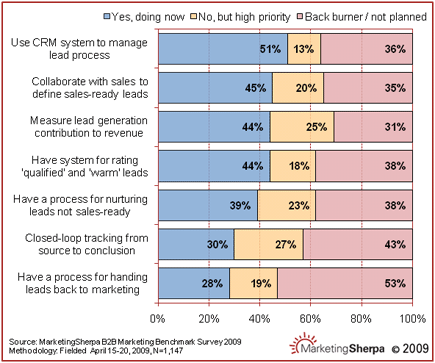A couple of weeks ago MarketingSherpa released the chart below. It shows the processes B2B marketers use (or in many cases don’t use) to manage prospects through the buying cycle. And there’s some biggies.
- Over half of marketers aren’t collaborating with sales to define sales-ready leads
- Over half of marketers have no system for rating leads
- Over 60 percent of marketers have no process for nurturing leads that aren’t ready to buy today
But here’s the thing I find most interesting. In the same B2B Marketing Benchmark survey, B2B marketers were asked to rate their most significant challenges. Here’s the top two:
- Generating high-quality leads
- Marketing to a lengthening sales cycle
What constitutes high-quality leads? A lead sales and marketing can agree on as sales-ready — something over half of marketers have no process for defining or rating. And from Sherpa’s own report, lead quality “may be the result of either the original state of the lead or of a nurturing process.” Except as this chart shows, well over half of marketers have no nurturing process despite the fact it would help with their top two identified challenges.
It’s easy to look at this chart and wonder, as Ardath Albee did, whether B2B marketers are missing the point. In a time when managers and budgets are under intense pressure, it seems like an obvious choice to tackle these processes. Without them, marketers face an uphill and losing battle.
However, I look at this chart and see a different problem. I worked on the development side of a technology company for a lot of years. Squeezing every last drop of efficiency from our processes was something we got to be very good at. (We had to or the jobs were going overseas.)
How did we get good at it?
We put processes into project management. The people running the processes were mired in the day to day stuff. They didn’t have time to define and document deliverables. They didn’t have time to gather requirements and refine what was already in place. In most cases, they were maxed out keeping what was there going.
So who had the time to make those changes? The project managers. That was their role and how they were evaluated for success.
This helped in a few ways. First, process change moved to the top of the to-do list. PMs usually had a short deadline so they got the job done in a fraction of the time it would have taken someone else.
Next, the tension and turf wars associated with the existing process were minimized. In this case it wouldn’t be sales telling marketing or marketing telling sales. It would be an unemotional third person finding out what each side needs vs. what they’re getting and negotiating an agreement.
And finally, if existing staff and resources can’t support the new process there would be documented proof of that…which is infinitely better than a frazzled manager complaining that their group “is maxed out.”
When I moved from development to the sales and marketing side of the business, it shocked me how little processes existed at all. It also surprised me how much of what was done was thrown together on the fly. A top salesperson requested a special piece of collateral? Marketing stopped to make it. A prospect worth a lot of dollars wanted a meeting with everyone? We stopped whatever else was going on to make the meeting happen. You get the idea.
I understand the sales cycle is fluid, and you have to make adjustments on the fly. But at least in this case, the normal state of being was that everything was an emergency. And when everything is an emergency, there’s no process…much less time to make up a new process that doesn’t exist yet.
Looking at this chart, I have to wonder if the normal state of most marketing departments reflects emergency and chaos. Thus more than half of all respondents put processes that would help them to the “I can’t deal with that now” or the “It’s a nice dream but on the backburner” realms.
Could project management rescue marketing from this state?
I think it could.
What do you think? Is lack of structure the real issue for most marketing departments? Or do B2B marketers just not get it?

